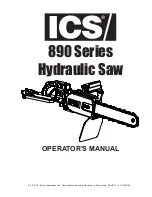
Baker Blue Streak Portable or Stationary Band Sawmill - Rev 2, 03/07;
WWW.BAKER-ONLINE.COM
13
Leg locking bolts
and jam nut
Leveling jack
handle and
insertion point
Jacking holes
Leveling leg
handle
Machine Positioning
(
Placement and Alignment
)
For optimum performance, designate a solid and level foundation that is covered, dry and
free of environmental elements such as rain or snow that could cause electrical or slip
hazards.
Ensure the wheels are blocked front and rear.
Ensure all safety chains, brake and light connectors are unhooked from the tow vehicle.
Rotate the hitch jack to the vertical position and install the locking pin.
Remove the cotter pin from the sawmill hitch coupler and pull up on the t-handle latch to
release the hinged ball socket head from tow vehicle hitch ball.
Rotate the jack handle clockwise and raise the mill off the tow vehicle hitch ball.
Move the tow vehicle forward and out of the way.
Adequate sized wood blocks or steel plates may be placed under each leveling leg to
improve stability on soft ground.
Provide sufficient workspace clearance on all sides, especially around off-load area.
Use a 1-1/8" wrench to loosen the two jamb nuts and bolts on
each leveling leg (see
Figure 13
).
Hold the leveling leg handle with one hand
and with the other hand press down on the
yellow leg lock release handle and allow
the leg to slide to the ground.
After the leg is on the ground, tighten the
leg locking bolts.
Repeat this procedure for each of the
remaining leveling legs.
Figure 13
Leveling leg lock
release handle
Figure 13A
NOTE:
Leg locking bolts must be tightened prior to
moving the carriage head up and down the track
NOTE:
Leg locking bolts must be tightened prior to
moving the carriage head up and down the track














































